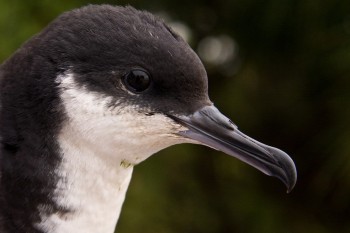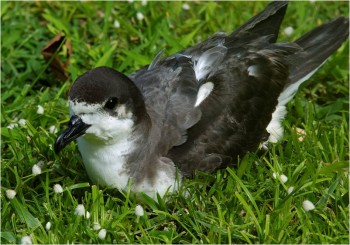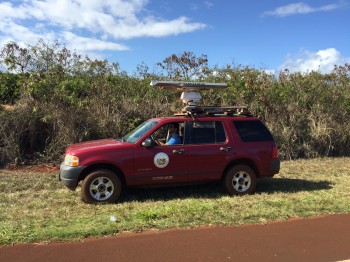The Kauai Endangered Seabird Recovery Project (KESRP) has commenced its annual monitoring by radar of nocturnal flights of Endangered Newell's Shearwaters or ‘A'o Puffinus newelli and Vulnerable Hawaiian Petrels or Ua'u Pterodroma sandwichensis at night on the Hawaiian island of Kauai. Two radar trucks are being used at 18 sites along Kaumualii and Kuhio Highways along with some county roads. These sites have been chosen because they are areas where the seabirds are known to move between the sea and their montane breeding grounds. The radar surveys are conducted at night during the first two hours after dark and two hours before dawn when the birds travel to and from their inland breeding sites (click here).
Radar truck on Kauai, photograph courtesy of the Kauai Endangered Seabird Recovery Project
“Radar is an important tool for tracking seabirds moving at night and is used around the world for this purpose”, said Dr. Andre Raine, KESRP project coordinator. “Because these two species of seabirds only fly back to their colonies at night it extremely hard to see and count them. Radar allows us to ‘see' the birds flying overhead in the darkness as a series of dots passing across the radar screen. By assessing the speed of movement, the direction of travel, and the time that the event is recorded, we can then identify the birds to species.”
Radar has been used to study the movement of nocturnal seabirds on Kauai – and other islands—for many years. The first radar surveys were conducted on the island in 1993 and have continued at the same sites on a near annual basis.
“By surveying the same sites every year, we can see how our endangered seabirds are doing by looking at the change in the number of birds passing by the same sites each year,” Dr. Raine said. “Because Kauai holds 90 percent of the world's population and a significant proportion of the world's population of Ua'u, understanding how the populations are changing at an island level is critical to their conservation.”
Radar observations will continue until September, with the peak of activity this month.

Newell's Shearwater, photograph by Eric Vanderwerf

Hawaiian Petrel, photograph courtesy of the Kauai Endangered Seabird Recovery Project
The KESRP is a Hawaiian Division of Forestry and Wildlife project, administered through the Pacific Studies Co-operative Unit of the University of Hawaiʻi at Manoa. Formed in 2006, the project focuses primarily on the three procellariiform seabirds that breed on the island of Kauai: Newell’s Shearwater, Hawaiian Petrel and Band-rumped Storm Petrel Oceanodroma castro.
John Cooper, ACAP Information Officer, 05 June 2015

 English
English  Français
Français  Español
Español 